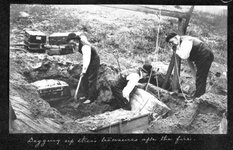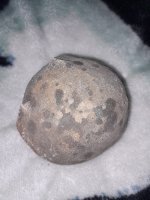pegleglooker
Bronze Member
- Jun 9, 2006
- 1,857
- 237
- Detector(s) used
- ace 250
- Primary Interest:
- All Treasure Hunting
This is a different twist to and old story......
PLL
Grace Under Fire
Like a dog shaking a rag doll, the most destructive earthquake in American history shook San Francisco at 5:12 a.m. on April 18, 1906. It ruptured gas lines and ignited dozens of fires, many of which soon merged into the disaster's single largest blaze. Eyewitnesses estimated that this "fire fiend," as one observer called it, reached 20 stories high. Its temperature exceeded 2,000 degrees, hot enough to melt steel.
With its water mains damaged by the quake, the city surrounded on three sides by water found itself unable to quench the flames, which burned out of control for three days. By the time the last embers were finally out, five square miles had been incinerated, some 28,000 buildings were destroyed, and an estimated 3,000 people were dead.
On that first morning 100 years ago, thousands of dazed San Franciscans—shaken by the earthquake and choked by smoke—grabbed what they could and fled for their lives. They caught ferries across the bay to Oakland or made their way to hastily established refugee camps in Golden Gate Park and around the edges of the city.
But right in the path of the largest, hottest blaze, a few dozen men at the San Francisco Mint, where coins were manufactured for circulation, stood fast. Led by a political appointee with no experience in crisis management, they fought back against an inferno that melted the glass in the mint's windows and burned the clothes off their backs. They didn't consider themselves heroes; their accounts of that hellish day are remarkably matter-of-fact. But heroes they were, brave and a bit lucky. Although their story is largely forgotten, by safeguarding gold and silver worth $300 million—the equivalent of more than $6 billion today—they may have saved the U.S. economy from collapse.
At the time gold was first discovered near Sacramento in 1848, California was a collection of sleepy Mexican villages with a population of 15,000. Barely two years later, when California entered the Union as the 31st state, its population had soared to nearly 100,000.
But the new state's development was hampered by monetary chaos. Small transactions were handled by barter; for larger ones, gold dust was the leading medium of exchange. As hordes of gold seekers flooded the Golden State, legal tender also included Mexican reals, French louis d’ors, Dutch guilders, English shillings, Indian rupees, and U.S. dollars and coins struck by some 20 private mints. These mints sprang up to handle the bags of nuggets that came down from the diggings to San Francisco, the state's financial and population center. "It was clear," says Charles Fracchia of the San Francisco Museum and Historical Society, "that California needed standardized currency."
To end the confusion, Congress authorized a U.S. mint in San Francisco to begin operation in 1854. Within a year the tiny mint—just 60 square feet—had turned $4 million worth of gold bullion into U.S. coins. When tons of silver began pouring into San Francisco after the discovery of Nevada's Comstock Lode in 1859, the Treasury Department needed a larger mint. It acquired a city block in a run-down neighborhood of boarding houses, cheap hotels and tenement apartments—built, like most of San Francisco, of wood.
The mint that would rise on the site, then known as the New Mint, was designed by Alfred B. Mullett, architect of the Old Executive Office Building in Washington, D.C. The building, inspired by Greek temples, opened in 1874: "The fire department," exulted the daily San Francisco Call, "will have little trouble quenching any conflagration that may arise within its walls." With a price tag of $2.1 million—which wouldn't buy half the land under it today—the stately three-story edifice was constructed around a large central courtyard with a well, and featured granite stairs rising from the street to a dramatic portico with fluted sandstone columns. Inside, the rooms boasted marble fireplaces and Honduran mahogany woodwork. Elaborate iron railings lined the interior stairs. The entire building sat on a granite-and-concrete foundation five feet deep, designed to keep thieves from tunneling into the vaults. Although little beyond the base and the outdoor staircase was granite, someone dubbed the building the Granite Lady, and the name stuck.
Click here for the rest of the story
http://www.smithsonianmag.com/history-archaeology/earthquake.html
PLL
Grace Under Fire
Like a dog shaking a rag doll, the most destructive earthquake in American history shook San Francisco at 5:12 a.m. on April 18, 1906. It ruptured gas lines and ignited dozens of fires, many of which soon merged into the disaster's single largest blaze. Eyewitnesses estimated that this "fire fiend," as one observer called it, reached 20 stories high. Its temperature exceeded 2,000 degrees, hot enough to melt steel.
With its water mains damaged by the quake, the city surrounded on three sides by water found itself unable to quench the flames, which burned out of control for three days. By the time the last embers were finally out, five square miles had been incinerated, some 28,000 buildings were destroyed, and an estimated 3,000 people were dead.
On that first morning 100 years ago, thousands of dazed San Franciscans—shaken by the earthquake and choked by smoke—grabbed what they could and fled for their lives. They caught ferries across the bay to Oakland or made their way to hastily established refugee camps in Golden Gate Park and around the edges of the city.
But right in the path of the largest, hottest blaze, a few dozen men at the San Francisco Mint, where coins were manufactured for circulation, stood fast. Led by a political appointee with no experience in crisis management, they fought back against an inferno that melted the glass in the mint's windows and burned the clothes off their backs. They didn't consider themselves heroes; their accounts of that hellish day are remarkably matter-of-fact. But heroes they were, brave and a bit lucky. Although their story is largely forgotten, by safeguarding gold and silver worth $300 million—the equivalent of more than $6 billion today—they may have saved the U.S. economy from collapse.
At the time gold was first discovered near Sacramento in 1848, California was a collection of sleepy Mexican villages with a population of 15,000. Barely two years later, when California entered the Union as the 31st state, its population had soared to nearly 100,000.
But the new state's development was hampered by monetary chaos. Small transactions were handled by barter; for larger ones, gold dust was the leading medium of exchange. As hordes of gold seekers flooded the Golden State, legal tender also included Mexican reals, French louis d’ors, Dutch guilders, English shillings, Indian rupees, and U.S. dollars and coins struck by some 20 private mints. These mints sprang up to handle the bags of nuggets that came down from the diggings to San Francisco, the state's financial and population center. "It was clear," says Charles Fracchia of the San Francisco Museum and Historical Society, "that California needed standardized currency."
To end the confusion, Congress authorized a U.S. mint in San Francisco to begin operation in 1854. Within a year the tiny mint—just 60 square feet—had turned $4 million worth of gold bullion into U.S. coins. When tons of silver began pouring into San Francisco after the discovery of Nevada's Comstock Lode in 1859, the Treasury Department needed a larger mint. It acquired a city block in a run-down neighborhood of boarding houses, cheap hotels and tenement apartments—built, like most of San Francisco, of wood.
The mint that would rise on the site, then known as the New Mint, was designed by Alfred B. Mullett, architect of the Old Executive Office Building in Washington, D.C. The building, inspired by Greek temples, opened in 1874: "The fire department," exulted the daily San Francisco Call, "will have little trouble quenching any conflagration that may arise within its walls." With a price tag of $2.1 million—which wouldn't buy half the land under it today—the stately three-story edifice was constructed around a large central courtyard with a well, and featured granite stairs rising from the street to a dramatic portico with fluted sandstone columns. Inside, the rooms boasted marble fireplaces and Honduran mahogany woodwork. Elaborate iron railings lined the interior stairs. The entire building sat on a granite-and-concrete foundation five feet deep, designed to keep thieves from tunneling into the vaults. Although little beyond the base and the outdoor staircase was granite, someone dubbed the building the Granite Lady, and the name stuck.
Click here for the rest of the story
http://www.smithsonianmag.com/history-archaeology/earthquake.html




